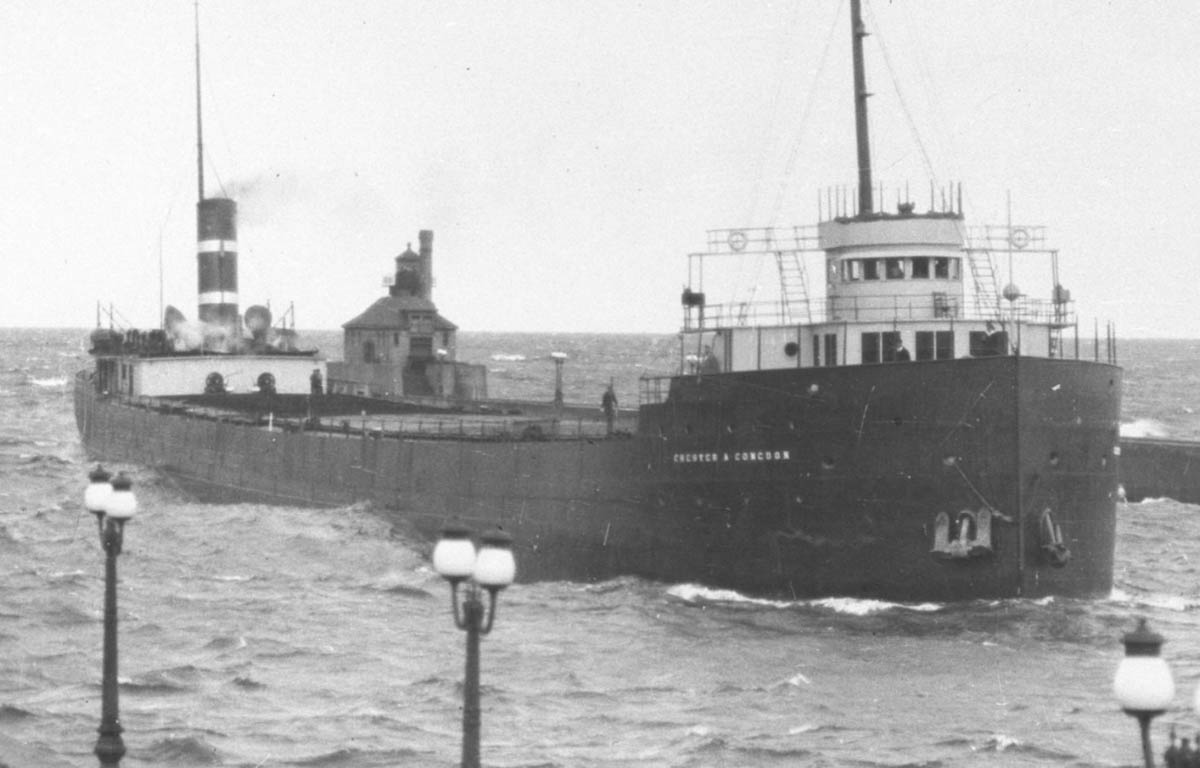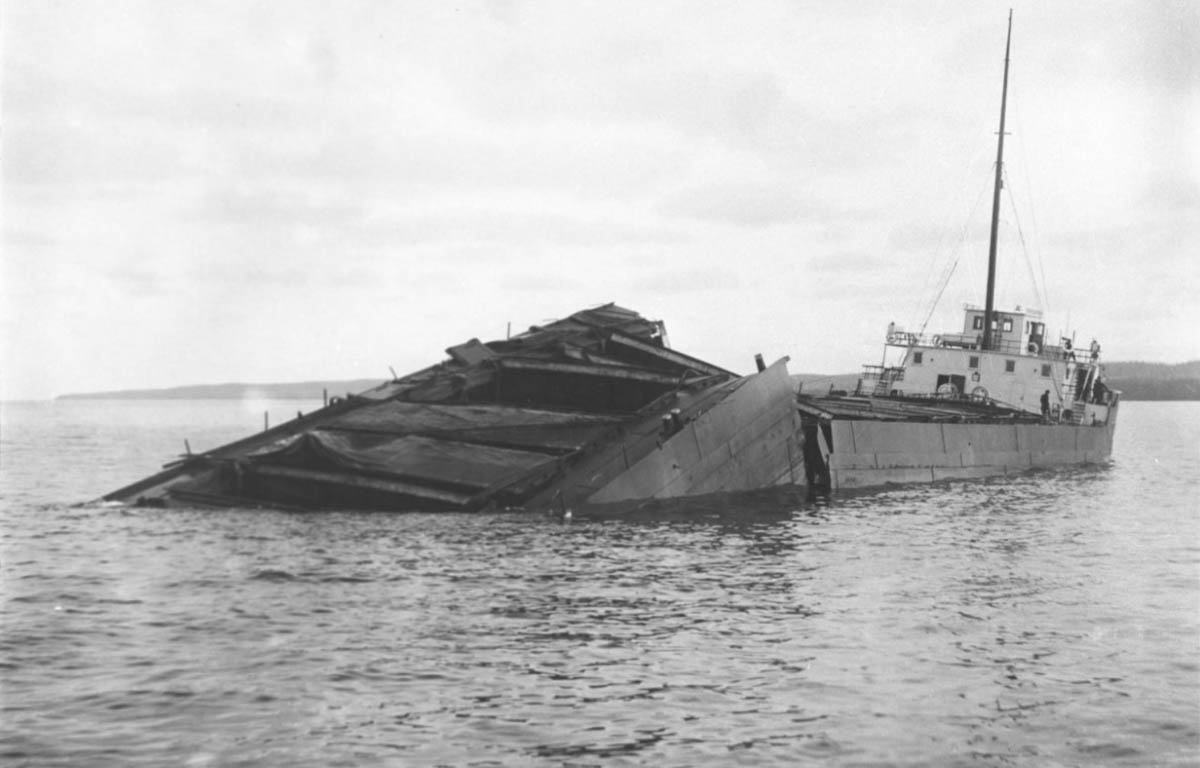SS Chester A. Congdon (originally Salt Lake City) was a steel-hulled American lake freighter that served from 1907 to 1918. She was built in 1907 for the Holmes Steamship Company by the Chicago Shipbuilding Company of South Chicago, Illinois, and was intended to be used in the grain trade on the Great Lakes. On September 19, 1907, she made her maiden voyage and entered service. Salt Lake City was sold to the Acme Transit Company in 1911. A year later, she was sold to the Continental Steamship Company and renamed Chester A. Congdon after lawyer and businessman Chester Adgate Congdon. Throughout her career, she was involved in several accidents.
Salt Lake City (SS Chester A. Congdon) was built in 1907 by the Chicago Shipbuilding Company in South Chicago, Illinois. She was launched as hull 74 into the Calumet River on August 29, 1907. Dorothy Holmes christened her for W. A. and H. B. Hawgood’s Holmes Steamship Company in Cleveland, Ohio. Salt Lake City was the third and final ship in the “10,000-ton capacity class.” At a Great Lakes shipyard, she set a record for the quickest completion of a ship between its launch and maiden voyage. Salt Lake City was built for use in the Great Lakes grain trade.
Salt Lake City’s hull measured 552 feet (168.2 meters) overall and 532 feet (162.2 meters) between perpendiculars. Her beam was 56 feet (17.1 meters) wide (some sources say 56.16 feet (17.1 meters) or 56.2 feet (17.1 meters)). Her hull was 31 feet (9.4 meters) deep (some sources say 26 feet (7.9 meters), 26.42 feet (8.1 meters), 26.5 feet (8.1 meters), or 27 feet (8.2 meters). Salt Lake City had a net register tonnage of 4,843 tons and a gross register tonnage of 6,530 (or 6,371.39) tons. She was powered by a 1,765 hp (1,316 kW) 83 rpm triple expansion steam engine with cylinder diameters of 23.5 inches (59.7 cm), 38 inches (96.5 cm), and 63 inches (160.0 cm) and a stroke of 42 inches (106.7 cm). Two coal-fired, induced-draft 180 pounds per square inch (1,200 kPa) Scotch marine boilers, 14.5 feet (4.4 m) in diameter and 11.5 feet (3.5 m) long, provided steam for the engine.
On September 11, 1907, Salt Lake City was enrolled in Cleveland, and her home port was Fairport, Ohio. On September 19, she set sail from the shipyard under the command of Captain James Owen. The Holmes Steamship Company merged with the Acme Transit Company, which was led by H. B. Hawgood, in 1911. Salt Lake City was sold to the G. A. Tomlinson-managed Continental Steamship Company of Duluth, Minnesota on February 2, 1912. She was renamed Chester A. Congdon after the lawyer and businessman Chester Adgate Congdon. Her home port was changed from Seattle to Duluth.

Tragedies
Chester A. Congdon was in Milwaukee, Wisconsin, in April 1912, when she broke free from the tugs towing her and collided with the freighter Charles Weston, damaging two of her own hull plates in the process. On August 10, that same year, while waiting for fog to lift on Lake Michigan, Chester A. Congdon drifted onto a shoal about 4 miles (6.4 km) north of Cana Island. She damaged 90 hull plates and approximately 50 frames before arriving in Superior, Wisconsin, on August 20 for ten-day repairs.
Chester A. Congdon collided with the breakwater in Fairport Harbour on September 26, 1913, damaging her steering quadrant. In Fairport, she was repaired. Due to low water levels, the bilge of the Chester A. Congdon scraped along the bottom near Grosse Pointe, Michigan, in October 1915. She was repaired in Superior after several of her rivets sheered off, causing her hull to leak.
Final Voyage
Chester A. Congdon arrived in Fort William, Ontario, on November 5, 1918, and loaded 380,000 bushels of wheat at the Ogilvie & Pacific grain elevators. The next day, at 2:28 a.m. (EST), she sailed from Fort William to Port McNicoll, Ontario, under the command of Captain Charles J. Autterson. Chester A. Congdon encountered a heavy storm shortly after passing Thunder Cape. Captain Autterson decided to return to Thunder Bay for 7-8 miles (11.3-12.9 km) and anchor until the storm passed. At 10:15 a.m., Chester A. Congdon returned to open water. The wind had died down by that point, but the waves remained. A thick fog descended on Lake Superior after she passed Thunder Cape. At 10:40 a.m., Captain Autterson set a course for Passage Island, intending to run for 2.5 hours at a speed of 9 knots (17 km/h; 10 mph) before anchoring if the fog remained. The Chester A. Congdon ran aground on the southern reef of Canoe Rocks, on the northeast point of Isle Royale, at 13:08 p.m., her officers having failed to hear the fog signal from Passage Island. The lifeboats were launched, with one heading to Passage Island (about 7 miles (11.3 km) away) to seek assistance from the lighthouse keeper. A launch carrying two fishermen arrived on the scene to assist. The fishermen took the second mate to Fort William, but the launch broke down, causing them to arrive at 6:00 a.m. on November 7. J. Wolvin, manager of the Canadian Wrecking & Towing Company, dispatched the wrecking barge Empire, as well as the tugs A.B. Conmee and Sarnia, to the wreck after the second mate relayed the news.

Aftermath
When the freighter sank, no one died. The wireless operator on Empire, on the other hand, was seriously injured when his thigh became entangled in the hoisting gear. Her cargo was only removed in quantities ranging from 50,000 to 60,000 bushels. At more than $1.5 million (equivalent to $18.1 million in 2021), she was the Great Lakes’ largest financial loss to that point, as well as Lake Superior’s first $1 million shipwreck. Wheat cost $2.35 per bushel as a result of the First World War (equivalent to $28.00 in 2021). Chester A. Congdon’s cargo was worth more than $893,000 (equivalent to $10.8 million in 2021), her hull was worth $365,000 (equivalent to $4.41 million in 2021), and her disbursements were worth $369,400 (equivalent to $4.46 million in 2021).
Chester A. Congdon and her sister ship D.R. Hanna (lost on Lake Huron in 1919) were the largest shipwrecks on the Great Lakes until the loss of the self-unloading freighter Carl D. Bradley in 1958. The freighter Edmund Fitzgerald (lost November 10, 1975) is still the largest shipwreck in Lake Superior today.
Dive Information
The bow is on the south side of the reef now known as Congdon Shoal in 60-120 feet (18.3-36.6 m) of water, and the stern is on the north side in 20-210 feet (6.1-64.0 m) of water. The bow is positioned at the base of an underwater cliff at an angle ranging from 35° to 59°, with the partially damaged stem pointing towards the shoal.
The wreck has an intact pilothouse and forecastle deck, as well as penetrable living quarters and a windlass room through a hole in the forward deck. The stern section has an intact engine room and stern cabins and sits at a steep angle. When the stern hit the bottom, the rudder was driven through the deck. Pieces of her hull are floating in 10 feet (3.0 m) of water on top of the shoal.
On June 12, 1984, Chester A. Congdon’s wreck was added to the National Register of Historic Places. She is the third most visited shipwreck on Isle Royale (after the lake freighter Emperor and the excursion steamer America), with over 150 dives made out of the 1062 dives made to other wrecks that year.






